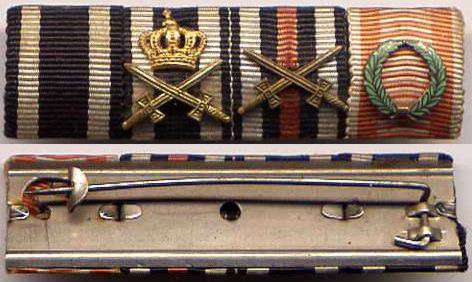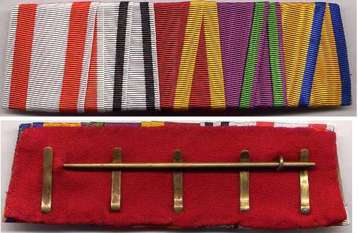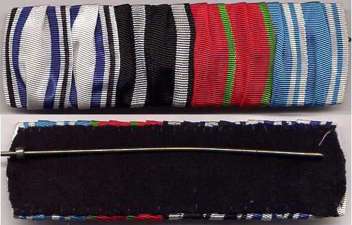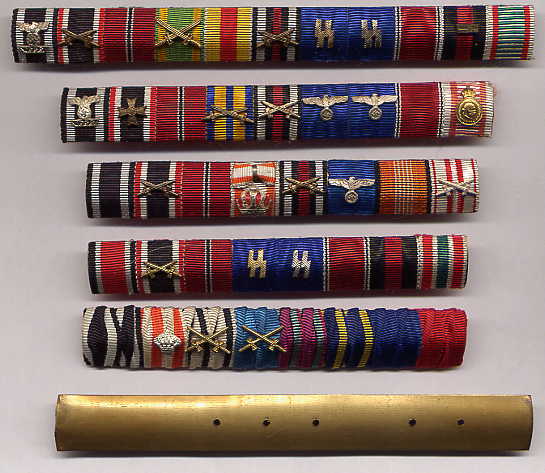
Content - Richard Lundström
Layout - Sebastian Bianchi
The Good, The Bad, and The Ugly: Strange Bars, Fakes, and Period Mistakes
This section will illustrate perfectly original ribbon bars that may at first appear odd or unlikely, but are not-"The Good." Ribbon bars that are mis-mounted, incorrect, and would normally raise suspicions, but are typical original PERIOD mistakes-"The Ugly"-will be compared with "The Bad," the sloppy, absurd-and increasingly dangerous-fakes flooding the collectors market today.
Fronts and backs of many original ribbon bars have already been shown so far to help familiarize collectors with normal types. More detailed descriptions will appear in the section which follows this one, on Construction of good-and bad-ribbon bars. Close up galleries of devices will also spotlight differences in real and fraudulent items.
"The Good"
Very few German awards allowed for the same ribbon to be worn with more than one of the "same" decoration on any bar. Austria-Hungary's use of the same ribbon for more than two dozen valor and war merit decorations is the prime exception, followed by Prussia's "Iron Cross" ribbon used, with distinguishing devices in most cases, for multiple war Orders and decorations. Most Imperial German states that provided for any second award of a same class decoration at all, employed either a suspension crown, oakleaves, and so on. Adding those to the basic award required the return of the former and only the higher grade was worn. In actual practice, parsimonious Orders Chanceries would often not issue the higher grade until the former had been returned and receipted. Violations occurred in the 1920s, but never before and not often under the Third Reich.

RV
These are examples of cases where "double" same ribbon awards WERE worn, all in compliance with regulations. This Saxon officer's bar is in the correct native Saxon awards before Prussian precedence followed to 1935 by the former "co-equal" Kingdoms of Wilhelmine Germany. The two Albert Orders with swords ribbons represent a Knight 1st Class won as a Captain with a Knight 2nd Class received as a Lieutenant.

This mid-1930s south German style bar shows Third Reich "Reichs" Iron Cross first precedence, with either a Bavarian Military Merit Order 4th Class or Military Merit Cross 2nd Class (both had silver swords ribbon devices) preceding a Military Merit Cross 3rd Class with Crown and Swords, given only to enlisted ranks up to the old army rank of "Sergeant." Absence of an NCO's long service ribbon means the original owner was probably a Leutnant first decorated while still an officer candidate. Bavaria sometimes awarded these Crosses and Orders "with Crown" as an initial award rather than a second of the same grade, for exceptional merit. Until 1935 Bavarians wore their home state awards before Prussia's. Note the gold swords rather than correct bronze ones on the Hindenburg Cross ribbon. This was a common fashion statement, perhaps for greater contrast with the dark ribbon's stripes. Bavarian MMC3 swords are also often encountered in incorrect gold rather than bronze, as correctly displayed here.

CE
Rather than being reversed, the devices on this Bavarian WWI veteran's bar unambiguously reveal a Military Merit Order 4th Class with Swords ahead of a Military Merit Cross 2nd Class with Crown and Swords. Presence of the "odd" north German Mecklenburg war ribbon (used by both -Schwerin and -Strelitz, so this is another ribbon where two of the same one might be found on one bar) on this south German group is readily explicable. The Grand Duke of Mecklenburg-Schwerin was Honorary Colonel-in-Chief of Bavarian Infantry Regiment 21, and often bestowed his Friedrich Franz Cross on members of "his" regiment. There was ALWAYS a reason for multiple states' WWI awards-and absence of any explanation is a prime sign of current ridiculous fakes, where no possible connection can be imagined. Interestingly enough, the extremely well decorated wearer of this original ribbon bar was not recalled for military service again in WW2-note the "Reichs" level civil KVK2 in second place, ahead of his three non-Iron Cross state level combat awards. Recipients often incorrectly placed a rear area civil war merit award like this behind their old frontline awards. The Regulations section details mounting order rules.

Prussia bestowed three classes of Red Cross awards. The 1st Class was a pinback cross, but the silver 2nd Class and bronze (wartime zinc) 3rd Class medals could be worn together, as here, when a holder of the 3rd Class subsequently received a 2nd Class. This is one reason why later 1922, 1937, and 1939 Red Cross/Volkspflege awards may sometimes be found paired with each other, when those regulations stated the same class or a higher one replaced the lower 1922-39 types.

The tiny Principality of Waldeck was one of the exceptions to the rule that higher classes replaced lower awards-Waldeck allowed any received to be worn together. For such a small state, Waldeck's system of decorations allowed for considerable latitude in recognizing bravery, with wide rank and class ranges. Since the Principality's entire award rolls for World War One have been published by Michael Autengruber (thanks to the indefatigable Erhard Roth), it is possible to cross-check all "double Waldecks" and compare with the roll of WW1 Prussian Hohenzollern House Order 3rd Class with Swords awards as well. There was only one match for this ribbon bar's original owner-Oberleutnant der Reserve Stracke of Infantry Regiment 83. His Waldeck Merit Cross 4th with Swords was awarded in 1914, followed by a 3rd Class in 1915, and his HHOX gazetted in late 1918. The seemingly anomalous Saxe-Meiningen ribbon results from the unique pairing of troop units-including Inf Rgt 83-from Waldeck and Meiningen in the 22nd Infantry Division. Again, there must always be a reason for multiple Imperial state combinations.

What is the reason for no Hindenburg Cross on this ribbon bar? The wearer was on active military duty in March 1897 (Wilhelm I Centenary Medal in last place), was a career NCO (blue long service) who served in the Herero-Hottentot War of 1904-06 (third ribbon-enlisted men almost never got the steel version, so he must have been "in country"), and was still in some sort of civil service uniform after 1938 (40 Years Faithful Service Cross next to last position). So-what Life Story does this odd and "boring" ribbon bar tell? That the wearer did his 12 years career enlistment, then went into the civil service before WWI. Although only then in his 30s or early 40s, he was never called back to WWI military duty-hence, no Honor Cross, though he did pick up a Prussian War Effort Cross (2nd ribbon). He was still a retirement age uniformed civilian when he received a 1940+ civil KVK2 in the Second World War! We will never be able to tell what grade of 1922-45 Red Cross/Volkspflege decoration he wore in the middle of his group. Whatever it was, he placed it incorrectly ahead of his Imperial and Third Reich long service awards. Which brings us to-
"The Ugly"
One of the more common period errors from the 1930s was this incorrect use of a green wreath for the gold "War Decoration" wreath found on the Austro-Hungarian Military Merit Cross 3rd Class, the basic award given by that country to German officers in WW1.

Note that on this particular example, the tab back style, a single piece double woven ribbon has been used in the center, the two ribbons of which were mounted on a single two ribbon tab backing. Common awards combinations were frequently woven together to speed mounting. Ordinarily the double ribbons here if alone would have represented a WW1 Iron Cross and Hindenburg Cross- perhaps the most common pair of any German awards. Flipping this bar over, the empty tab hole in the center at first looks like two tabs have broken off-a fairly common drawback with this type, especially at the ends. Absence of scratches shows this bar is exactly as made-it has never been altered or repaired, despite the unusual construction and mix of ribbon types.

This enormous post-1938 Austrian WWI veteran's group is made even wider by the deluxe doubled south German style mounting. As is often the case, this mammoth bar did not, in fact, belong to a "field marshal," but probably a junior enlisted man, whose lack of long service awards of any type would suggest that whatever uniform he wore this on, he was likely no more than a "retread" NCO in the Second World War. After two WWI bravery ribbons, the Karl Troop Cross, combatants' Hindenburg Cross, 1918 Austro-Hungarian two Wounds Medal (usually updated to the German 1918 pinback badge), and Austrian WWI Commemorative Medal, incorrectly mounted Hungarian and Bulgarian WWI Commemorative Medals ribbons precede Tyrol's WWI Commemorative Medal and the Anschluss Medals for Austria 1938 (suggesting the wearer was a Nazi of some ilk) and the Sudetenland 1938. The Hungarian and Bulgarian WWI medals should, of course, be last in precedence as foreign awards. They are, however, often found mounted mingled among the sort of repetitive arrays shown here (SIX awards simply for participation in WW1 frontline operations… where an "average" German would have had nothing but the Hindenburg Cross!). This is a prime example of a "normal" period error. Note the quite peculiar safety pin type method of attachment-though from the solid and well made construction, this appears professionally done, and not handmade improvised. Austrians, of course, only wore German style ribbon bars after their country had been absorbed into the Third Reich: for earlier styles, see the section following on "Related" items.

RV
This ribbon bar never fails to cause a double take. Because of the incorrect double Saxon long service awards at the end, this can be dated after October 1936. The creation of the Third Reich's Wehrmacht long service awards, worn in 25 & 12, 18 & 4, 12 & 4, and single 4 combinations, led to misinterpretation that the regulations for NEW "Wehrmacht" long service awards' wear also applied to the OLD "Wehrmacht." The 1936 regulations did not, in fact, authorize double Imperial wear as here-but this sort of period error was quite common. The first three awards are from the First World War, showing this man was then a Saxon officer. The very peculiar "Iron Cross" ribbon in 4th place actually undoubtedly indicates a Prussian Militär-ehrenzeichen 2nd Class, awarded in tandem with the then newly created Saxon Friedrich August Medal on war ribbon-for service in Southwest Africa 1904-06. So this man was a career NCO who worked his way up into the officer ranks in continuous service, suggesting a technical branch like Ordnance where such long NCO service preceded commissioning. With the double time regulars were credited with for overseas and WWI service, this man probably had a XXV Years Service Cross, which he was wearing here improperly with either an XV Years Service Cross or XII Years Service Medal, whichever he had actually last received at the outbreak of WW1. If this former officer was called back up for Second World War MILITARY duty, like any other military holder of old Imperial military long service awards, he would then have exchanged his old XXV per regulations for the new Wehrmacht 25 and 12-but only on call up into the Wehrmacht.

MK
Sometimes Third Reich precedence regulations were so confusing, it is not even possible to determine whether a ribbon bar is correctly mounted-or not! When originally created in 1940, the lowly Kriegsverdienstmedaille (middle) was officially positioned after the WWI Honor Cross, not in front of it, as here. Normally given for minimal war industry industrial service, collecting for the war effort, and that sort of minor merit, it is unusual to find the KVM with any other WW2 award except perhaps a KVK2 civil type. This KVK2, with Swords, suggests an interesting career, perhaps civil defense related in an area threatened by bombing-or perhaps the WWI noncombatant was "combed out" of industry and sent into Wehrmacht service. By the end of the war, the KVM's precedence had been officially changed to in front of campaign awards-as shown here (rather suggesting "inactivity" on altering placement of lifesaving awards was… quite deliberate…). But the swords device is an early war type… so was this wearer ahead of changing regulations? We'll never know.
"The Bad"
What I do know is that over half a century after the end of the Second World War, there are probably more German ribbon bars in existence than were ever worn then. Sadly, based on observations of the internet, dealers' catalogs, and militaria shows, fakes to originals -particularly long ribbon bars- are in a ratio of 9 in 10 bad.

TP
Some, like this sloppy and inaccurate mockup of Manfred Freiherr von Richthofen's awards are relatively "harmless." Very few people are actually going to believe that they are the first person to "discover" the Red Baron's awards floating around at a yard sale or show-especially when the same bar appears on half a dozen tables, hmmm. Ditto the "Rommels" and "Himmlers" found at every show. The busiest mass producer of these long years ago began running out of often common original ribbons to butcher, and so bars like this often mix and match unused original stock, "West German veterans" ribbon stock-and since many Third Reich awards were banned, so there ARE no "Model 1957" versions of them, outright fakes. Whether a "display" item like this is worth the waste of original parts is another question. Many original devices have also run out, as the producer of these has equipped "divisions" over the last two decades. Original devices will often be found painted to improvise unobtainable ones, and especially in the case of Third Reich devices with swastikas etc, crude cast copies are used. Some of those will be shown in the x500% Devices Gallery section.

TP
A re-enactor Old Style bar like this, worn by the "Prussian Military Attaché" at U.S. 1861-65 Civil War re-enactments, even when as well made as here, should never "fool" anyone. The ribbons are, of course, all modern synthetics, not silk originals. An internet scan might not reveal that, but one touch will.

TP
This replication of a WWI Bavarian "Old Style" full sized ribbon bar was actually personally made by Yours Truly, to order for a re-enactor. Again, the ribbons are modern synthetics, not silk, a fact readily apparent not only by touch, but by flashing with a black light. Modern ribbons with white will all flush that color a bright electric blue, which NO original will EVER do. A black light is now an absolutely essential tool for anyone collecting ribbon bars, no matter how experienced. Correct fraudulent WW2 ribbon bars are few and far between, but they do exist.

CE
This is not one of them. Until the last year or so, most fake ribbon bars have been a jumble of preposterously impossible awards in idiotic precedence, like this one. We can call such horrors "Where Eagles Dare" monstrosities, Hollywood-Nazi glitz run amok. A collector's first defense with ribbon bars is to know what the ribbons are, and what went where, when. It is only necessary, with some effort and time invested, to take just one look at a bar like this and walk away. No need to blacklight, no need to flip for a sight of the typical fraud's all brass hand snipped construction. What do we see here? A WW1 Iron Cross, 1941/42 East Medal, Hindenburg Cross with Swords, then a peacetime pre-WW1 Austro-Hungarian Franz Joseph Order as normally given only to Captains and Majors--with ca 1917+ miniature device, a Wehrmacht 4 Years Service Medal with oddly finished eagle-all on its lonesome, an Austro-Hungarian junior NCO's wartime Silver Merit Cross on war ribbon-per the mini, an Austro-Hungarian Franz Joseph Signum Laudis on the war ribbon-mini again, and Hungarian WW1 Commemorative Medal. Instantly, we see a mid-level pre-1914 officer reduced to the wartime ranks, with a medal-the Signum Laudis-indicating wartime service as an officer-again. That medal was NEVER awarded on non-K.u.k. officers-in which case, we are blatantly missing a 1908 Military Jubilee and Troop Cross ribbon, at the very least. How an officer at least a captain before 1914 could "only" have 4 years of combined military service for his Wehrmacht Long Service award is another impossibility. Failed originality count-this is only worth what its good PARTS would be. Because our prolific forger had endless boxes of little used Austrian miniature ribbon devices (frequently found on 40 mm singles from WW1), over use of these, and incorrect use of these is a major tip-off for many fake ribbon bars. You don't even need to turn them over.

MK
This hideous example is the forlorn result of what happens trying to stretch out Third Reich-only fantasy bars. It just can't be done with the few possible ribboned awards that were created after 1933. This one would have us believe that a WW2 Iron Cross and KVK2X winner held a Volkspflege award "with Swords" (I have yet to see a verifiable original-play those odds!), with 18 and 4 years army or navy service (note the dull, oddly finished fake eagles-as if saying they are ashamed of themselves), then a Luftschutz Medal (common enough for over-aged rear area types, but not for a frontline Super-Medic!), and then 1939 Memel and 1938 Sudeten Medal in the wrong order. This combination just will not fly. The mismatched swords on the Volkspflege are out of place (though owner and collector repairs and odd personal fashion statements do sometimes show such discrepancies), the odd, dull supposed to be "frosted" finish on the typical fake eagles, and the no Third Reich German would have screwed up Memel/Sudeten order all shout "fake" at 10 paces-IF you know your ribbons, know regulations, and know who could have gotten what.

Here are typical over the top fake long bars. After seeing dozens of originals, you will observe that reality rarely looked like these Frankenstein creations cobbled together out of bits and pieces, and most commonly slapped onto entirely brass backings. (More on the underpinnings in the next section.) Even "Imperial" bars are not immune to very decent looking attempts at fraud, as the bottom bar shows.
The top bar boasts the Mashed Marshmallow Easter Chick fake 1939 EK2 Spange. Note the distorted, stumpy right hand (as viewed) wing, attempting to cover the shamed avian's view of the following embarrassment. Ever present KVK2X and East Medal always help stretch things out, then we have a Baden Order of the Zähringen Lion with Swords and semi-cleverly, a Baden Silver Merit Medal on the war ribbon-as if the forger was actually giving some thought to this one. Sadly, things go all to the dickens after the Hindenburg Cross. TWO sets of SS runes are always, immediately, the kiss of death. Only one could be worn. With very, very limited exceptions where a silver 12 Years Cross's runes might be worn without an NSDAP 10 Years Service Cross (some career Waffen-SS personnel were not Nazi Party members, odd as that seems), to find ANY SS runes, let alone TWO without NSDAP long service awards following is a fundamental tip-off of fraud. As mentioned in the exotica section, in 35 years, the ONLY original SS runes ribbon bar I have ever seen is the one pictured in this article. The Marshmallow Spange and SS Runes are fakes, the other devices are original, as in this case are all the ribbons. Another tip-off of forgery is the wiggly, meandering placement of the devices. Try to get a straight line through the center hole that should have been punched in every ribbon space on original commercially produced ribbon bar backings-you can't. It is no surprise to turn this over and find all brass hand snipped construction, with holes only where the lazy sloppy forger knew devices were going to go.
The second bar from the top shows Marshmallow Chick Spange again. The bizarre KVK2 miniature is apparently an original lapel bow device, but not something that will ever be seen on an original ribbon bar. Other frequently misused lapel bow devices are wound badges atop crossed swords, or Polizei eagles atop crossed sword. Those will never be found on anything original except lapel bow ribbons. Notice the lifeless dull fake eagles again, and the never possible Signum Laudis to a German officer we are supposed to believe came from Schwarzburg. It is also 1942+ from the East Medal, and yet there rides the impossible Signum Laudis in pre-Anschluss last place. Final nails in this one's coffin: the last ribbon flares bright electric blue under blacklight, and the wiggling devices show, sure enough, all brass handmade backing.
The third bar must have been a really early, Ronald Reagan era trial run. With seemingly inexhaustible supplies of Prussian Red Eagle Order ribbon, our enthusiastically goofy faker can never rein in his "Where Eagles Dare" impulses, and goes for the ludicrous. A bow (note the hand snipped brass "ring"- over sloppily painted crown would indicate a pre-WW1 award to a full Oberst-someone about age 50 in 1914… with only the strange dull frosted Wehrmacht 4… in 1942+. Not bad for a supposedly 78 year old retread General with a Leutnant's seniority. Ghastly devices wiggle, silver instead of gold swords on the Austrian WW1 Commemorative (pre-1938 precedence after 1942, again!). Do we really need to go look at the all brass backing?
Second from bottom bar-we've covered all this. The only devices as abused as SS runes are NSDAP 25s and semi-imaginary Blood Order "Feldherrnhalles," closely followed by commander grade Red Cross/Volkspflege unenamelled "Kleindekorations." Run away from SS runes like these.
The south German bar at bottom is exceptionally well made. It would look very nice in "Where Eagles Dare-II." Its maker's innate sloppiness and inattention to correct regulations make it a very nice "anything goes" 1920s bar indeed. Luckily for us, back then ribbons were either silk or cotton-NOT 1930s+ synthetics.
The reverses show the rest of the horror;

Notice that every single one of these has a catch hook hand snipped out of thin sheet brass, some with visible pencil guide lines. Ah, craftsmanship! The backings on these are all brass-a material almost never used on any original M1915+ ribbon bars with the exception of half height ones, with brass pins. Brass was a strategic metal in WW2. Pins will sometimes be found in brass into the mid-war years, but I have NEVER seen an original brass backing after the 1930s, except on half height bars, as will be detailed in the next section. Note the sloppy holes, drilled only where the lazy forger knew devices were going, wiggling all over. Original commercial metal backings form the 1930s (and some from WW1) were almost invariably STAMPED with a hole in the center of each space, since the metal backing maker had no way of knowing what would be mounted to each space by the military effects tailors. Commercial catch hooks were always stamped as well. All shall be revealed… next!
![]()
© Copyright Wehrmacht-Awards.com LLC |